

Everything you've ever wanted to know about blocks and more...
Written by Brandon Nicholas in 2003.
Copyright www.440source.com
If you haven't read our page on An explanation of Chrysler's part and casting number system, be sure to check it out also.
And, if you are interested in where and how these engines were originally produced from the factory, check out our article on Chrysler's Trenton Engine Manufacturing Plant
Blocks are one of the most misunderstood aspects of building a big block Mopar engine. Never has there been more misinformation, propaganda and rumors floating around. In the many years we have been involved with the big block Mopar engine, we have seen and owned many many hundreds of used core engines. We have used this opportunity to try and keep records as much as possible as to different advantages and disadvantages that various blocks offer. All the facts listed below are the result of our independently testing, measuring, sonic checking or otherwise gathering information directly from original sources: either the blocks themselves or the original factory drawings (blueprints) that Chrysler used to manufacture the blocks. This eliminates all chance of secondhand information, rumors, marketing or sales talk, etc. Hopefully this page will help hobbyists, restoration experts, and racers decide which choice of block is best for them.
First, let us address the biggest myth of all:
For many years it was thought that late model blocks were thin wall and should not be bored more than .030 over.
On page 198 of the Mopar engines manual, (the 8th edition) in the "B-RB Engines (block) section, it states: "The 1976-1977-1978 blocks for the 400 and 440 are a thin wall casting design. As such they shouldn't be overbored more then .020." This quote can now be found on page 58 of the new "Big Block B/RB Engines book from Mopar Perfomance, part # P4876825
Two pages later, (pg. 200) under "Boring and milling specifications," the manual states: "...The newer blocks (1975-1978) should only be bored .030" max., because they are thin wall castings. This quote can now be found on page 64 of the new "Big Block B/RB Engines book from Mopar Perfomance, part # P4876825
Then, in the May '98 issue of Mopar Performance News, in an article titled "The Big Block Story" on page 16, it states: "The newer production 440 blocks, '73-4 to '78 are thinwall cast, so you can only bore them .020"..."
So, as you can see, even these multiple sources of info which come straight from Chrysler engineering contain different information. What is the Mopar enthusiast supposed to think? Are the thinwall blocks from 76-78, or are they from 73-78? Can you bore them .030, or is .020 the maximum? We will answer all these questions once and for all based on scientific fact. The purpose of citing these books and articles is not to make Chrysler/Mopar Performance look bad. As racers and hobbyists, we are grateful for the resources and aftermarket parts that Chrysler makes available. However, it does demonstrate how even someone who does their research could be easily confused. So, it is to the benefit of everyone involved to help spread information which is known to be true, even if goes against popular thinking.
So what is the truth? Get ready for this.
There is no such thing as thinwall blocks. They DO NOT exist.
We have sonic checked over 50 blocks, and have found absolutely no evidence that later model blocks have cylinder walls that are any thinner then earlier blocks. In fact, we have found later blocks to have less core shift, meaning the cylinder walls are of a more uniform thickness all the way around. This makes perfect sense, considering that B engines were in production for over 2 decades. During this time, it would be expected that there would be small improvements in the technology of casting processes, quality control, etc, which would help create a better product.
There was also an article from Mopar Action magazine by Andy Finkbeiner of AR Engineering in which they sonic check 20 blocks and come up with the same findings we did. They also explain how statistically 20 blocks is enough of a sample to estimate the rest of the 440 blocks out there. We've tested over 50 with the same results. This article also has some great info regarding hardness of the iron used, in which they find that the earlier blocks do have slightly harder cast iron, by about 10%.
Another issue is block weight, or the quantity of cast iron which is actually used in the block. Like the Mopar Action article, we have weighed many blocks and have found later blocks to weigh more, or have more cast iron in them. Since the reasoning behind thin wall blocks is that the factory used this practice in the late 70's to save money on iron (which is a known fact with SB Chevy engines), the fact that later blocks weigh more shows that Chrysler had no intention of using less iron to save money. Which is great news for us racers and performance enthusiasts.
So, the bottom line? Save and use those late model blocks. And go .060" over with 'em all day long. Also on that note, we know of several machine shops that have been going .060" with late model blocks for over 20 years with no problems.
Fact #2:
There are SIGNIFICANT differences between blocks in the main bearing saddles and support webbing.
Lets start with "RB" raised deck blocks.

What you are looking at above is the number 2 main bearing support on a 75 or earlier 440. This is the area that surrounds where the top shell of the main bearings fit into the block, and the supports that lead from this point diagonally up into the block, to the bottom of the cylinders. The thickness of the main support is labeled "A" while the thickness of the metal forming a "shell" around the bearing is labeled "B." These are the two areas that differ considerably among different blocks, and we will focus on measurements of these two areas. Please note that all the measurements we are using in this section are averages off of multiple blocks, to eliminate the possibility of one block having more or less iron used as an irregularity. The "A" measurement typically is between 1.900" and 2 inches. "B" typically measures about .375" (3/8") All 440's cast before '76 and some after will have these main saddle support measurements. This includes ALL 2536430 (1966-72) blocks, ALL 3698830-440 (1973-74) and some 4006630-440 (Late 1975-79) blocks. I have also found 426 Hemis, Max Wedges and even Mopar's megablocks to also use these measurements. Now on to the late model 440 blocks...
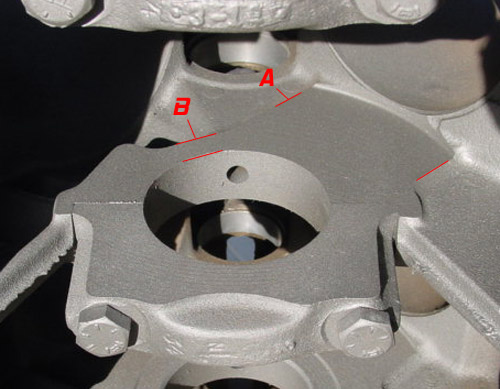
SOME 440's cast in '76 and later have CONSIDERABLY thicker main saddle supports. The only block we have found to have these supports are the 4006630-440 casting #, which was used from late 75 until the end of production in 1979. In case you have heard that 440's were discontinued in 1978, this was for cars only. 440's continued to be offered in trucks and motorhomes all through 1979, and we have had many 440 blocks stamped with the 1979 model year on them.
Shown above is a picture of a 4006630-440 (1978 model) 440 block. The "A" measurement typically is about 3.190". This is about 60% thicker than the early 440 blocks shown above. "B" typically measures about .520", which is still about 40% thicker. The blocks with these thicker supports were not cast during any specific date period. There is no external markings or numbers which show they are different from the other blocks. They DO seem to be more commonly used for truck motors, however just because you have a truck 440 does not mean it will automatically have the thicker main supports. One important fact is that while 4006630-440 casting # blocks are the only blocks we have found to have these thicker supports, not all these blocks will have them. There appears to be no other way to tell if a block has them or not other then actually looking at the supports themselves. Without the crank and rods removed from the block, it is very hard to tell.
Now on to low deck "B" blocks.
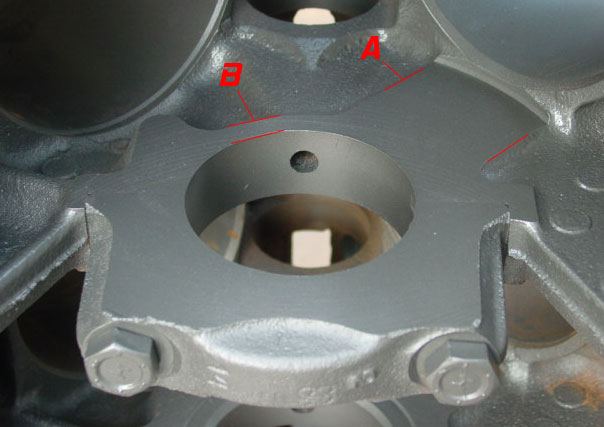
Shown above is a #2 main saddle off of a 1970 model 383. We have found all 71 and earlier low deck "B" blocks (including 361's, etc) to have this type of main saddles. "A" in this case measures between 1.900 and 2 inches, and "B" measures about .350" These are probably the smallest measurements of all the big blocks. Now lets compare this to the 400 blocks below.
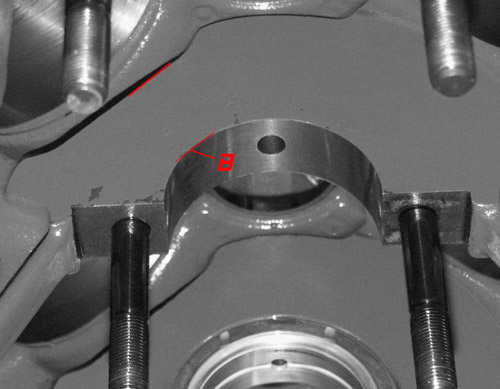
Shown above is a 3614230 (1971 Casting date) 400 block. These are the thickest of any blocks around, bar none. we didn't even bother to mark the "A" dimension because it is so huge it is practically off the map, and the "B" dimension came in at a whopping 1.350! When you compare this to the 383 and 440 pictures above it makes them look like a joke. One important side note however, is that there are some 3614230 blocks that DO NOT have the thick main supports. It appears that the 230 blocks with casting dates of October 1971 and earlier generally have the thicker main supports, but 230 blocks cast after this date do not. But, as always with mother Mopar, never say never. Before you spend hundreds of dollars to ship that block across the country, make sure it has the thick mains!! Be sure to always measure or at least see a clear picture.
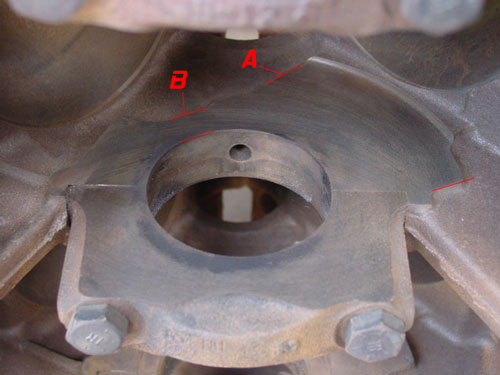
Moving on, if you can't seem to find the superblock above, a good second choice is shown above; a 1973 400 block, casting #3698630. Notice the main saddle supports are CONSIDERABLY thicker then both the 383 AND the pre-76 440 shown above. "A" in this case measures 3.750" and "B" measures .575! This is close to a quarter inch more metal in the area surrounding the bearing shell, and the support leading up to the cylinder is almost twice as wide! We have found the thickness of "B" to vary slightly, even among blocks with the same casting # cast during the same month of the same year. In this case we have found blocks between .525 and .575, but still worlds above the .350-.375 measurements listed above for 383's and 440's. Combine this with the fact that the cylinders are shorter (since the block deck height is shorter) compared to an RB, and you can see that a 400 block is ABSOLUTELY stronger then any other block made.
But wait, you say. "I know the early 400 blocks are good...I heard the later ones went back to thin supports...." WRONG (well mostly.)
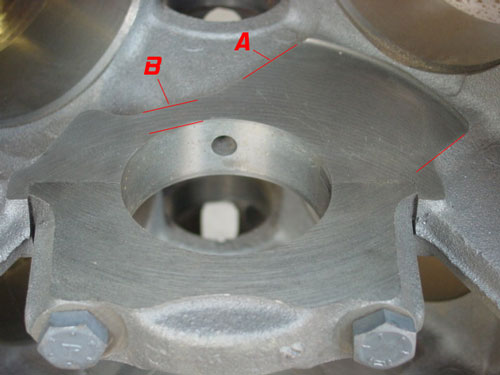
Shown above is the #2 saddle on a late model (76-78) 400 block, casting #4006530-400. The "B" measurement remains the same as the early 400 block at about .525 -.575, while the "A" goes down to roughly 3.300, making the support only less than half an inch narrower then the early 400 (still almost 90% of the width), and still over 1 1/4 inches wider then 383's and early 440's.
The end result? Pretty ironic. Chrysler famed powerplants that dominated the muscle car era, 383's and 440's have the weakest supports of all, while their "smog" motors, 400's and late model 440's, which couldn't get out of their own way, have blocks that are considerably more reinforced and able to handle much higher power levels.
There is absolutely no physical difference between a block with an HP or HP2 stamp and one without.
All blocks were cast and machined at the foundry, and then assembled at Chrysler's 2.1 million square foot Trenton assembly plant in Trenton, Michigan. During assembly, if the engine was given high performance cam and valve springs, or in some cases other items that differed between HP and non-HP engines such as: six pack rods, carbs, etc., then the engines ID pad would be stamped with HP. All blocks originally came from the same place, and there is absolutely no difference in cylinder wall thickness, nickel content in the cast iron, strengthening ribs on side of the block by the freeze plugs (see below for the real story on this,) or any of the other myths you have heard. The number 2, which you may find after the HP, (or in the case of non HP blocks, you may find just a "2" by itself, usually in the lower right hand corner of the ID pad) refers to the shift during which the engine was assembled. In running a factory, one 24 hour day can be divided into three 8 hour shifts. The first shift was considered a "1" however to save time, Chrysler did not stamp a "1", they just left it blank. So an HP2 engine, only means that the engine happened to be assembled on the second shift. There is no advantage to an HP2 block over an HP. we have never seen an HP3, (or just a "3") although Chrysler does allow for it in their documentation, so let me know if you have one or have seen one. Also of note is that non-HP engines usually used the same heads, intake manifold, and many other parts, which is great since it makes it a lot easier to bring a non-HP engine up to the power levels of a factory HP and beyond. But unless you are doing an original restoration, don't worry about finding and/or paying extra for an HP block.
The strengthening "rib" or support can be found on all 440 blocks starting approximately with the 1969 model year, and ALL 400 blocks.
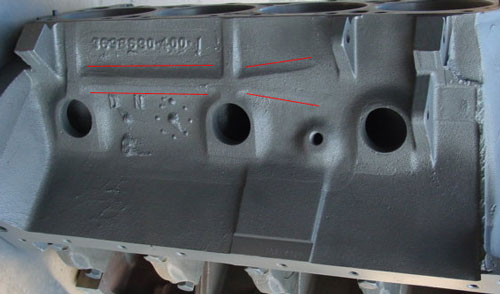
On the side of the block just above the freeze plugs, sometimes you will find a strengthening support or "rib" cast into the block. This was started in the 1969 model year on 440's (E 440 code on the ID pad), or approx mid '68 casting date. This is an improvement that was instituted around this time and lasted until the end of production. Every 400 block we have seen has this support, and NO 383 blocks we have seen have it, (Another small reason to build that 400 stroker...) Yes, blocks do occasionally crack around the freeze plug area, so it is considered desirable to find one that has this strengthening rib, however it is not a necessity, and certainly no reason not to use a nice 66-68 440 block you may find or have. As mentioned above, this rib has nothing to do with HP or non-HP. Notice also there is a slightly raised area in the center of the block, starting at the oil pan rail and leading up the skirt to the freeze plug area. The machined part of this (by the oil pan rail) was used to stamp the engines serial numbers. When an engine has the strengthening rib, it will usually have this pad as well. This explains why serial numbers were first used in this location in 1969. The only exception we have found is 70-71 383's... they will have the pad without the rib.

Shown above for comparison is an early block without the rib or pad.
Also, Chrysler did make an "industrial" big block engine block. It is casting number 2658836. These are sometimes referred to as "cold weather" blocks, such as on page 19 of Chuck Senator's "Big Block Mopar Performance" book from HP Books. The casting number on these can be hard to find, especially if the block is covered in rust and grime. It is across the top rear of the block, where the oil pressure sending unit would screw into. One part of the number (2658) is on one side, and the other part of the number (836) is on the other side. See picture below:
For most applications, this block was used for their "Heavy duty truck or industrial 413" engine. This is the setup with the huge (5 bolt) water pump and housing and very large cylinder heads. These engines were used in lots of motorhomes, large (semi) type trucks and other industrial applications such as generators, pumps, etc. The water jacket cores (or what could be considered the "outer walls" of the cylinders) from these blocks were essentially those from a 440 engine. 413 bore size is about 140 thousands smaller than a 440, making these blocks essentially an "underbored" 440 from the factory. This results in the cylinder walls usually being over .400" thick on these engines. This means that these blocks can be bored out to a 440 size, and used as a 440. Once this is done, it results in standard thickness cylinder walls of .250" (quarter inch) thick, which is Chrysler's standard specification for cylinder wall thickness.
Although the vast majority of these seem to have been made into 413's we have seen some of these made into 426's from the factory (often in boats for marine applications) and VERY rare examples where Chrysler themselves assembled and stamped these as a regular 440 at Trenton. This may have been due to a shortage of standard 440 blocks, or the need to use up "old" inventory, or some other similar "keep the line running" type of reason.
Unfortunately, the internal main webbing and main cap setup on these is identical to a standard 440, not any thicker. This was a missed opportunity. Imagine if Chrysler would have increased the main webbing thickness on these, similar to how they did on the early "230" casting 400 block, and maybe even gone with the cross bolt main capped Hemi type setup. We would have had "somewhat" plentiful 1000 horsepower capable factory "440" blocks available.
Interestingly, some early examples of these actually do have the "cross bolt" bosses cast into them, indicating that they were thinking of doing this, but never went ahead with it. Or they may have been cast only to use in the super stock programs. But these early examples are extremely rare. It is likely only one or maybe a few early production runs ended up with the cross bolt bosses. We've had hundreds of these blocks (most all out of motorhome applications from the late 60's/Early 70's), and none have ever had the cross bolt bosses. Here is a picture of the cross bolt bosses shown below:
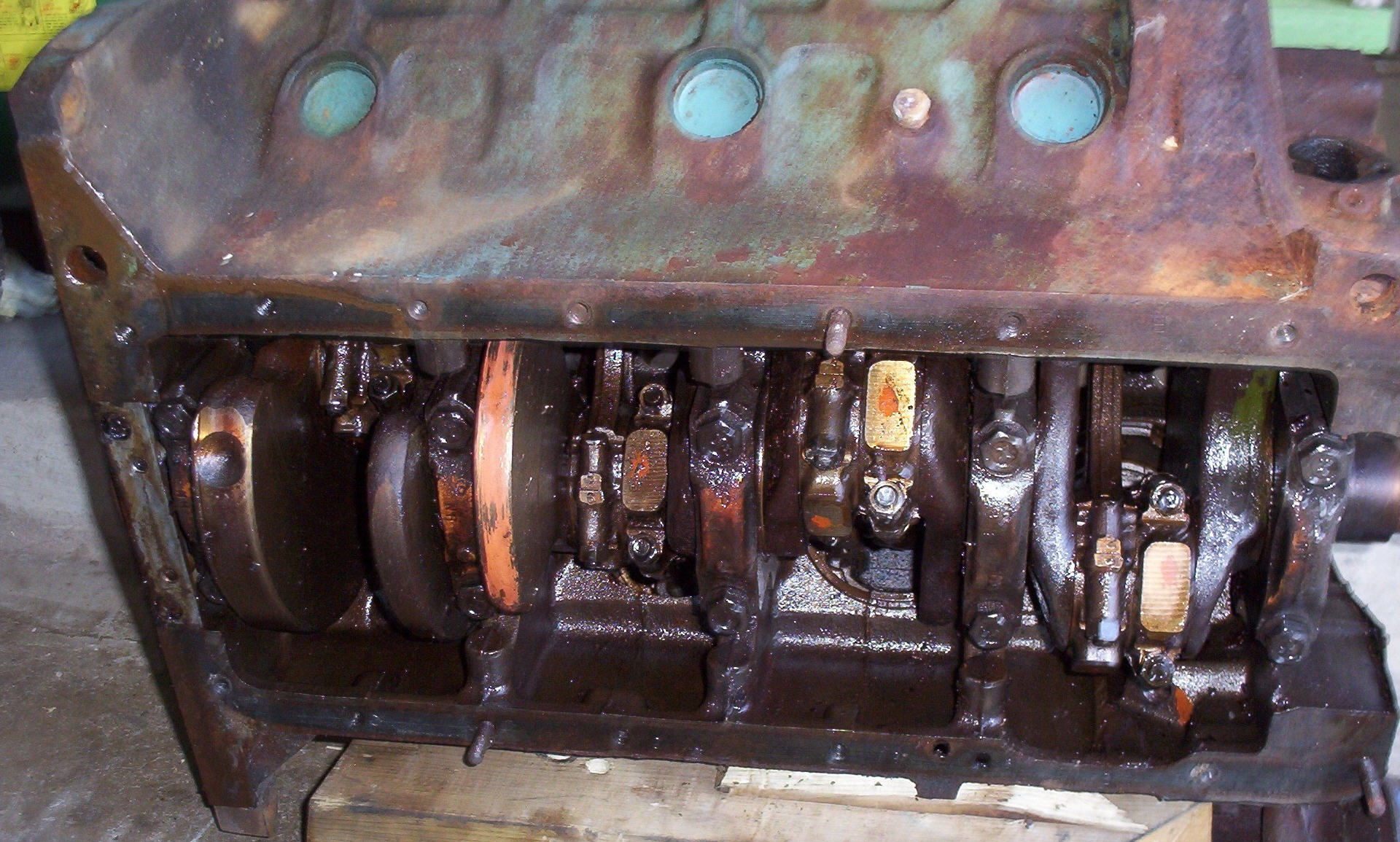
These blocks are easily identifiable by the unique webbing pattern on the side of the block, along with no obvious casting number near the webbing, which is where it normally is on most regular 440 blocks. The will have the date cast into them, along with other various single digits here and there, which is probably the number of specific cores used in the casting process. They also have large bosses cast into the top rear of the block on both sides. These were likely for tapping into the water jackets for some industrial or marine applications but are "blank" and not used in most cases. Here is a picture of those bosses shown below:
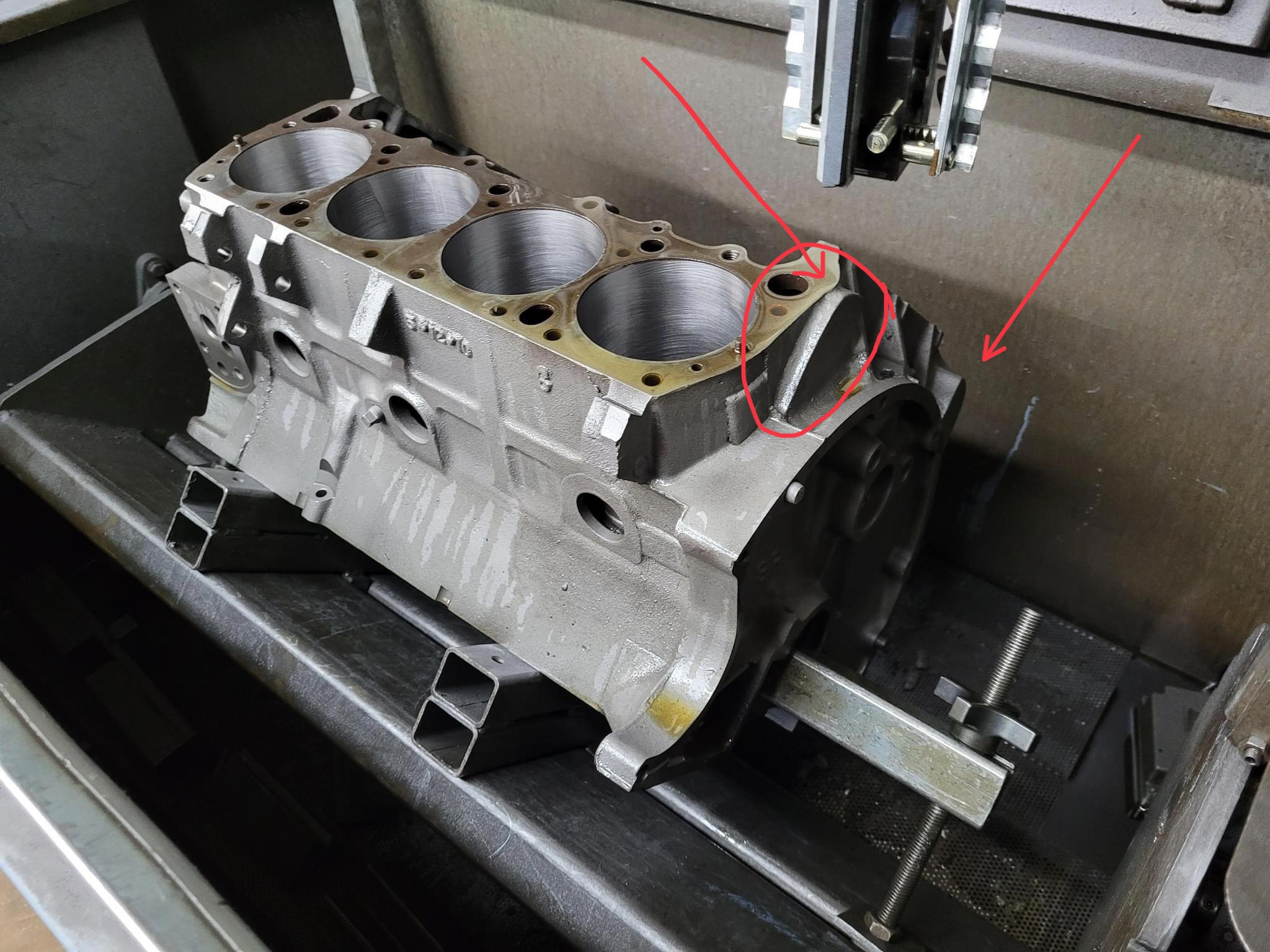
And finally, shown below is a clear picture of the side webbing one of these blocks:

The thickness of the mounting lugs or "ears" was increased starting in 1975.
One fairly common problem that big blocks are plagued
with is breaking off of the somewhat fragile "ears" or "lugs" on the side of
the block that the motor mount support brackets bolt to.
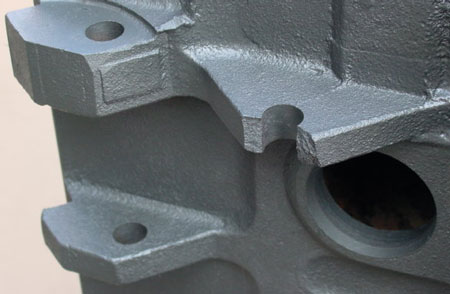
(Typical broken motor mount ear- common)
The engineers at Chrysler must have realized this, because starting in the 1975 model year (along with some other changes listed below) the thickness of these lugs was increased by about .200". This was done with both 400's and 440's.

Early (pre 75) block mounting ears on the left. Later (76-79) block mounting ears on the right. The difference is obvious. We rarely see the later blocks with cracked ears. Yet another reason to use late model blocks.
The cooling passages in the deck surface were changed.
This earlier style deck surface shown below with 3
smaller, perfectly round coolant holes between the cylinders (circled in
red) was used throughout most of the 60's and early 70's.

The later style deck surface uses larger ports for added cooling. (see below.) In the new "Big Block B/RB Engines book from Mopar Perfomance, part # P4876825, (pg. 58) these are referred to as "'figure eight' shaped cooling holes."

These enlarged passages came into use first in low deck "B" engines in the early 70's, being phased in on some 383's as early as the 1970 model year. By the time 400's were released in 1972, nearly all were using this later type of deck. In 440's it was first used in 1975 and continued until the end of production in '79. Some people like the added benefit of extra cooling, while others think the additional iron missing weakens the deck. Blocks don't commonly crack in this area, so to us the additional cooling seems like a good benefit.
The bellhousing design was changed slightly.
Like many of the changes listed above, this applies to ALL 400's, and 440's starting in '75 and continuing until the end of production. The design of the bellhousing was changed slightly, mostly in the top center, near where the oil sending unit screws in. The bolt pattern remained the same, and both early and late styles are completely interchangeable with transmissions, etc. however the appearance is slightly different, so it may be something to think about if you are going for an accurate restoration.

Shown above is an early style bellhousing, vs. late style shown below.
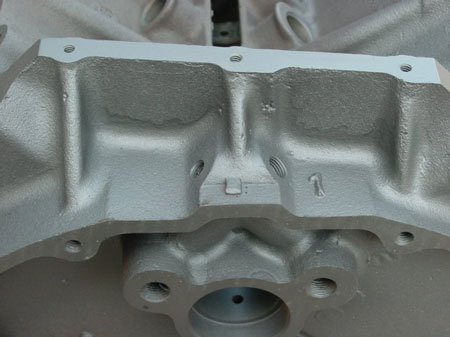
Also, here is an interesting article on core shift and Chrysler casting techniques, although it focuses on Slant Sixes http://www.slantsix.org/articles/dutra-blocks/slant-blocks.htm
Back to blocks casting numbers page
An explanation of Chrysler's part and casting number system
![]()
![]()
All website content copyright 440 Source
(775)883-2590